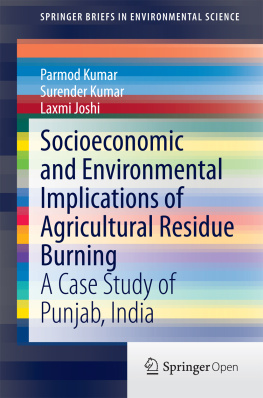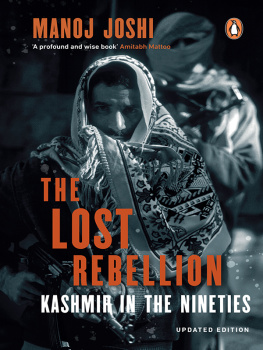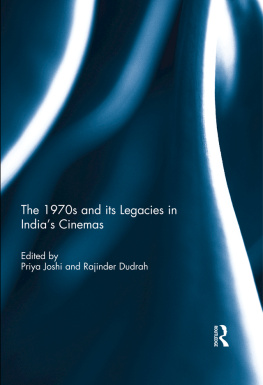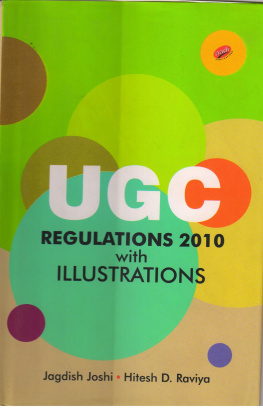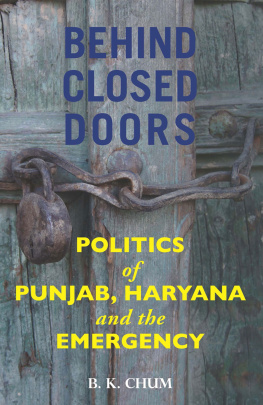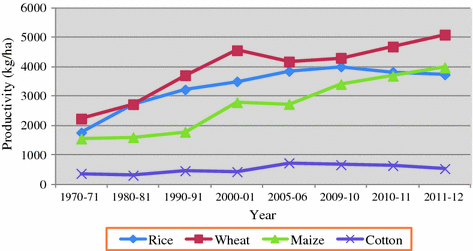1.1 Agricultural Growth in Punjab
The Indian state of Punjab is known as the countrys chief granary contributing almost one-fourth share of rice and more than one-third of wheat to the central pool. On an average, the states share in the total production of wheat and rice in all-India stands about 20 and 10 %, respectively. Table provides details of wheat and rice contribution by Punjab to the central pool over the last three decades. Further, above 95 % of food grains produced in the state go out of the state to feed food deficit areas through the public distribution system. The state agriculture is characterized as the backbone of the public distribution system and a strong base for the food security of the country.
Table 1.1
Contribution of wheat and rice to the central pool by Punjab
Period | Percent share of rice | Percent share of wheat |
|---|
19801981 | 45.3 | 73.0 |
19901991 | 41.0 | 61.0 |
20002001 | 33.3 | 57.6 |
20052006 | 32.0 | 60.9 |
20062007 | 31.2 | 75.3 |
20072008 | 27.8 | 60.9 |
20082009 | 25.1 | 43.8 |
20092010 | 29.0 | 42.3 |
20102011 | 25.2 | 45.3 |
20112012 | 22.1 | 38.7 |
20122013 | 33.6 |
Source Statistical abstracts of Punjab, various years
Punjab made a commendable progress in the production of food grains in the post-green revolution period. Food grain production underwent a big jump from 3.16 million tonnes in 19601961 to 28.35 million tonnes in 20112012. The green revolution also known as the new agricultural strategy was marked with the arrival of new high yielding varieties of wheat, rice, maize and bajra (millet) and package of other inputs like chemical fertilizers, insecticides, pesticides and assured irrigation facilities. Focusing on popularizing modern inputs and practices in the productive areas where the likelihood was more for the high yielding seeds to show results was the most important feature of this new strategy. Punjab with requisite irrigation and infrastructure facilities became a major beneficiary of this national strategy and has been shown as a showpiece of Indias successful green revolution strategy. Short duration and high yielding varieties (HYV) of rice and wheat were introduced in Punjab to boost up the production of food grains. During the first decade of the green revolution, the technology was confined only to the wheat crop. A remarkable growth rate of 5 % was achieved by the states agricultural sector since the beginning of the green revolution in the mid-1960s.
The decade from the mid-1970s to mid-1980s was characterized by the extension of new seed fertilizer technology from wheat to rice crop. Due to the input and output price structure and superior yields of rice and wheat as compared to other crops, Punjab agriculture has virtually become a rice-wheat monoculture. During 19661967, total area under rice was 0.29 million hectares, which increased to 2.82 million hectares by 20112012. There was also a substantial increase in the average rice productivity, which increased from 1,186 kg/ha in 19661967 to 3,741 kg/ha by 20112012 (Fig. ). During the same period, the area under wheat crop increased from 1.61 million hectares to 3.51 million hectares and productivity from 1,544 to 4,898 kg/ha. Punjab has achieved a crop intensity of 188 % as against 138 in the country as a whole. The present level of consumption of fertilizer (NPK) is 244 kg/ha as compared to the Indian average of 144 kg/ha. Similarly, Punjab has 98 % of high yielding variety coverage, which is the highest among the Indian states. About 18 % of the total tractors in India are in Punjab. Production is supported by about 97 % irrigation coverage with 970,139 tube wells.
Fig. 1.1
Productivity of major crops in Punjab
Given tremendous achievements in the past, however serious concerns are now emerging about the future prospects of Punjabs agricultural sector. Agricultural growth slowed substantially in the 1990s. Agricultural output grew at a trend rate of 2.6 % per annum in the 1990s compared to the all India average of 3.2 % and relative to a growth rate of 5 % per annum in Punjab in the 1980s. Productivity of rice appears to be reaching to plateau. The main rice-wheat tract of central Punjab also experienced a decrease in growth with total factor productivity (TFP) growth coming down to 0.07 % per annum mainly due to negative TFP growth in rice (Singh and Hussain ).
1.2 Agricultural Residue Burning and Its Management
The growth story of Punjab agriculture was accompanied by its negative environmental concerns. One of the concerns is about the over exploitation of ground water resources of the state. Punjab now has the highest percentage of ground water exploitation in the country and also the largest percentage of over exploited and dark blocks. As per the guidelines of Ground Water Resources Estimation Committee (GEC), the present ground water development (ratio of gross ground water draft for all uses to net ground water availability) in the state is 145 % as on March 2004. As per latest data provided by Central Ground Water Board, (Government of India out of 137 blocks of the state, 103 blocks are overexploited, 5 blocks are critical, 4 blocks are semi critical and only 25 blocks are in safe category. All the blocks of various districts like Amritsar (16 blocks), Jalandhar (10 blocks), Moga (5 blocks), Kapurthala (5 blocks), Sangrur (12 blocks), Fatehgarh Sahib (5 blocks), Patiala (8 out of 9 blocks) and Ludhiana (9 out of 10 blocks) have been found to be over-exploited, leading to sharp depletion of the water table in these districts.

